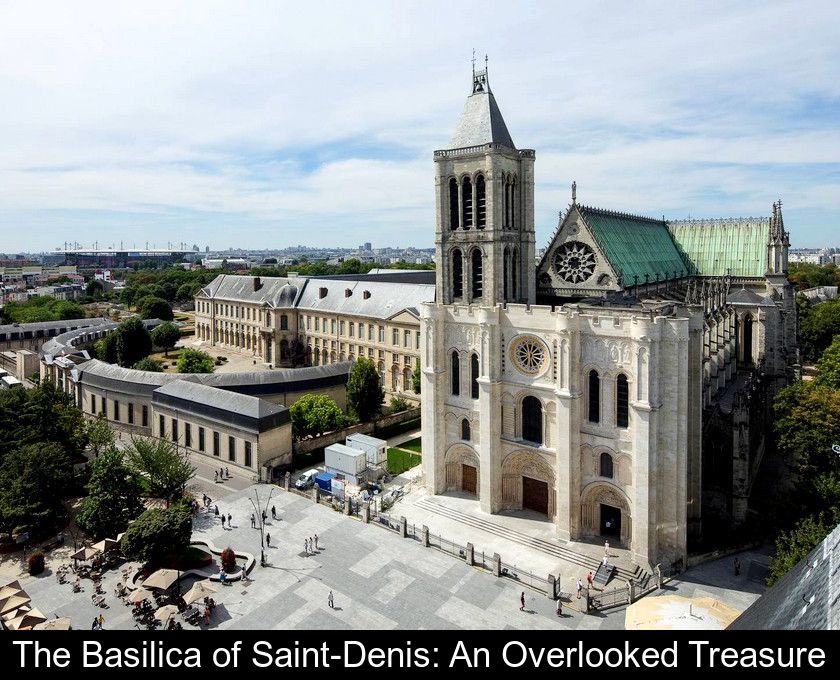The Basilica Of Saint-denis: An Overlooked Treasure
When visiting Paris and its surroundings, one primarily thinks of admiring Notre-Dame de Paris and the Sacré-Cœur... But it is often overlooked that the Paris region is home to another must-see monument for its history, architecture, and the great figures buried there. During my last stay in Paris, I was able to discover the Basilica of Saint-Denis, which is both the cradle of Gothic architecture and the necropolis of the Kings of France. I would like to share with you the images and opinions I gathered on site.
Saint-Denis, the forgotten cathedral
If you ask tourists passing through the capital about the monuments they wish to discover, it is unlikely that they will mention the Saint-Denis Basilica Cathedral... And yet, it is one of the most beautiful Gothic churches in the Paris region, with stained glass windows and ribbed vaults that rival those of Notre Dame de Paris!
The Saint-Denis Basilica, located in Saint-Denis to the north of Paris, is easily accessible by metro line 13. It is well worth leaving the capital for half a day to visit this building, especially since it holds particular historical significance and houses a unique collection of tombs and recumbent statues in Europe. A recumbent statue is a funerary statue representing a person lying down.
The cradle of Gothic art
The Basilica of Saint-Denis as you can visit it today was restored by Eugène Viollet-le-Duc in the 19th century. Founded as an abbey church, it was granted the status of cathedral of the Diocese of Saint-Denis in 1966.
But above all, this monument, listed as a historical monument since 1862, is considered the first monumental masterpiece of Gothic art. From the entrance of the church, one cannot help but be impressed by the portal and the delicacy of the sculpted columns surrounding the door. The wonder increases when entering the basilica and discovering the height of the vaults and the beauty of the multicolored stained glass windows from the 12th and 19th centuries. This basilica was the first building to be adorned with a rose window above a central portal.
In the 12th century, the abbot of Saint-Denis, Suger, was an influential political figure. He transformed the abbey into a masterpiece of early Gothic art by reconstructing the building according to the new techniques of the time, with ribbed vaults and roses, that is, large circular stained glass windows that bathe the church in light, symbolizing the divine.
An impressive royal necropolis
This cathedral, unlike any other, also deserves to be visited at least once in a lifetime for its royal necropolis and its collection of more than 70 recumbent statues and sculpted tombs.
Before discovering the Basilica of Saint-Denis, I was unaware that France had a royal necropolis, somewhat like the Valley of the Kings in Egypt... Whether one is passionate about French history, royalty, and funerary art or not, it is impossible to remain indifferent in front of the tombs of the kings whose names we all learned in school: Pepin the Short and his wife Bertha Broadfoot, Francis I, or Henry II.
It was in the 5th century that Saint Genevieve had a church erected at the supposed site of the tomb of Saint Denis, the first bishop of Paris, martyred around 250. The church, enlarged twice under the Merovingians, was chosen as a burial place by King Dagobert in the 7th century. From then on and for twelve centuries, from Dagobert I to Louis XVIII, almost all the kings and queens of France were buried in this basilica.
When I asked the people who visited this basilica with me for their opinion, they unanimously said: "I didn't expect that!" I think we often have a negative view of the city of Saint-Denis and are completely unaware of the treasures it holds... So, don't hesitate to take line 13 to the "Basilique de Saint-Denis" station and let yourself be surprised!
A place inseparable from royalty
The visit to the Basilica of Saint-Denis is like a dive into the History of France or, more precisely, into the history of French royalty. Very early on, this basilica established close ties with the monarchy.
42 kings, 32 queens, 63 princes and princesses, and 10 great servants of the monarchy are buried there today. Each new dynasty perpetuated the tradition of being buried there to affirm its legitimacy. It is also in this church that King Henry IV renounced Protestantism in 1593.
In 1793, the tombs of the kings were desecrated and the skeletons and embalmed bodies of the Bourbons were thrown into a mass grave. In 1816, during the Restoration, Louis XVIII ordered the reconstruction of the royal Necropolis. The remains of the monarchs were then placed in an ossuary installed in the crypt.
Today, one can see in the Saint-Louis chapel the kneeling statues of Louis XVI and Marie-Antoinette commissioned by Louis XVIII on the occasion of the return of the sovereigns' ashes to the royal necropolis.
A church at the crossroads of history and modernity
This monument open to the public is divided into two spaces: the church where Catholic ceremonies take place and a museum where the tombs of the kings and queens of France are displayed. The museum is closed during religious ceremonies. The museum entrance fee is 11 euros (in 2024), but the ticket price is well justified by the richness of the collections and the beauty of the site.
The Basilica of Saint-Denis also houses the first organ built by Aristide Cavaillé-Coll in 1840. This organ, preserved almost entirely in its original state, is one of the most beautiful instruments in France.
Today, this historic site also hosts contemporary artworks, either as part of temporary exhibitions or permanently, such as the installation Crescendo by American artist Stephen Dean in the apse of the basilica.
I was literally fascinated by this 15-meter-high structure made of stained glass whose color changes depending on the viewing angle. I walked around it several times trying to capture its changing colors and reflections, and I believe I succeeded in the photo below!




